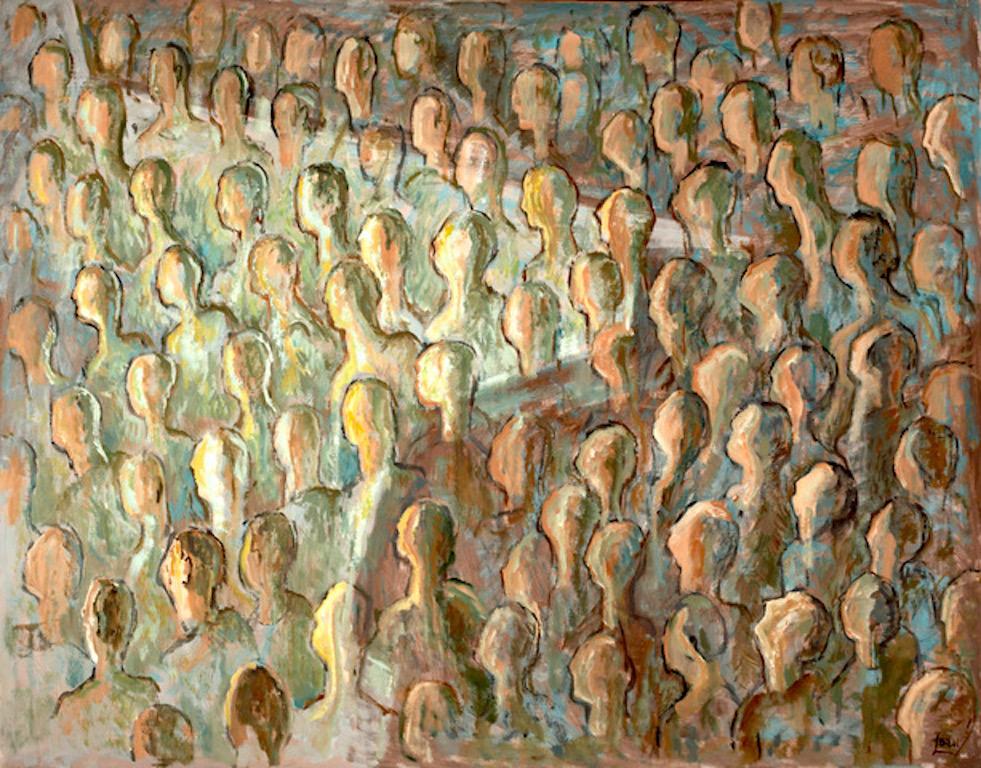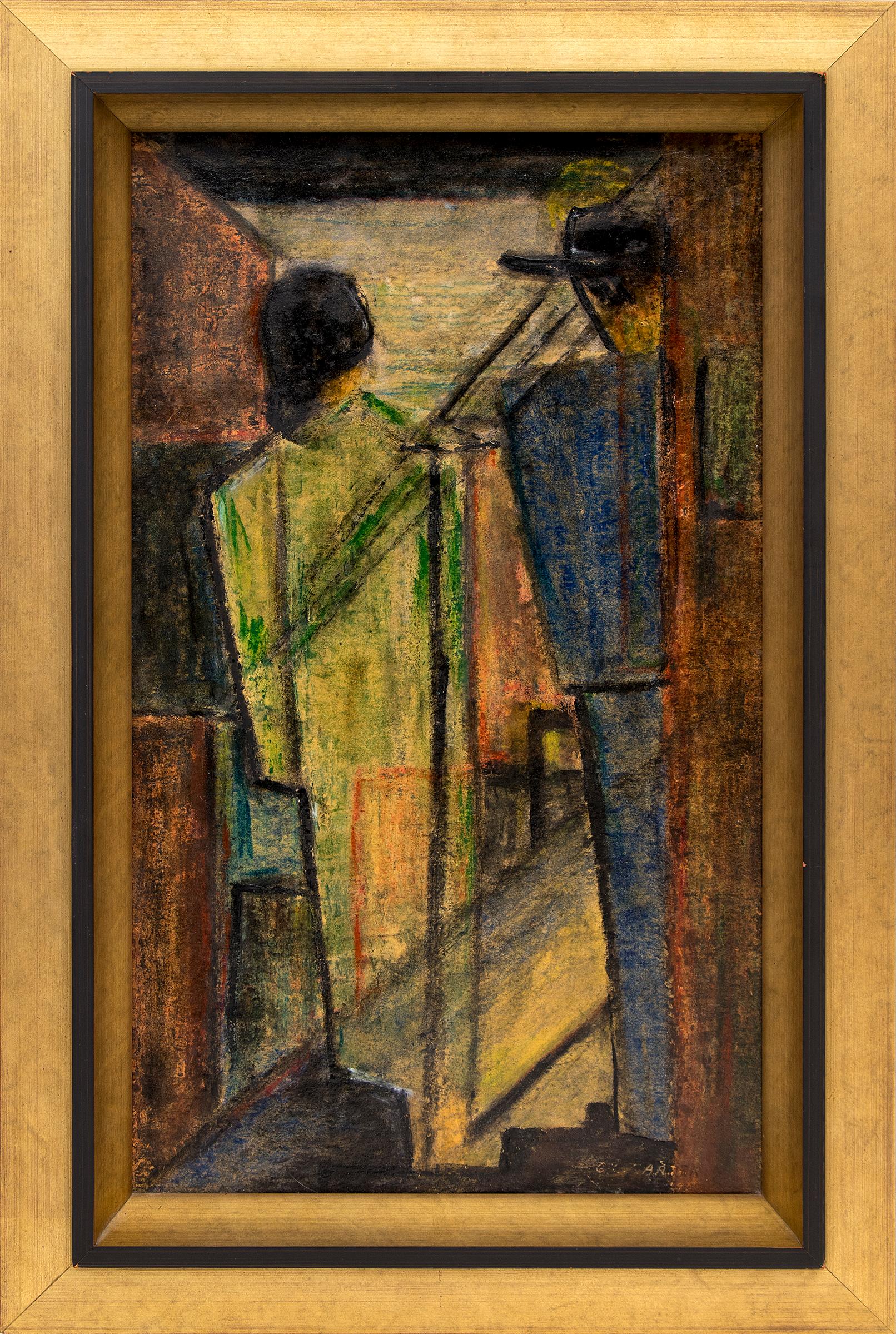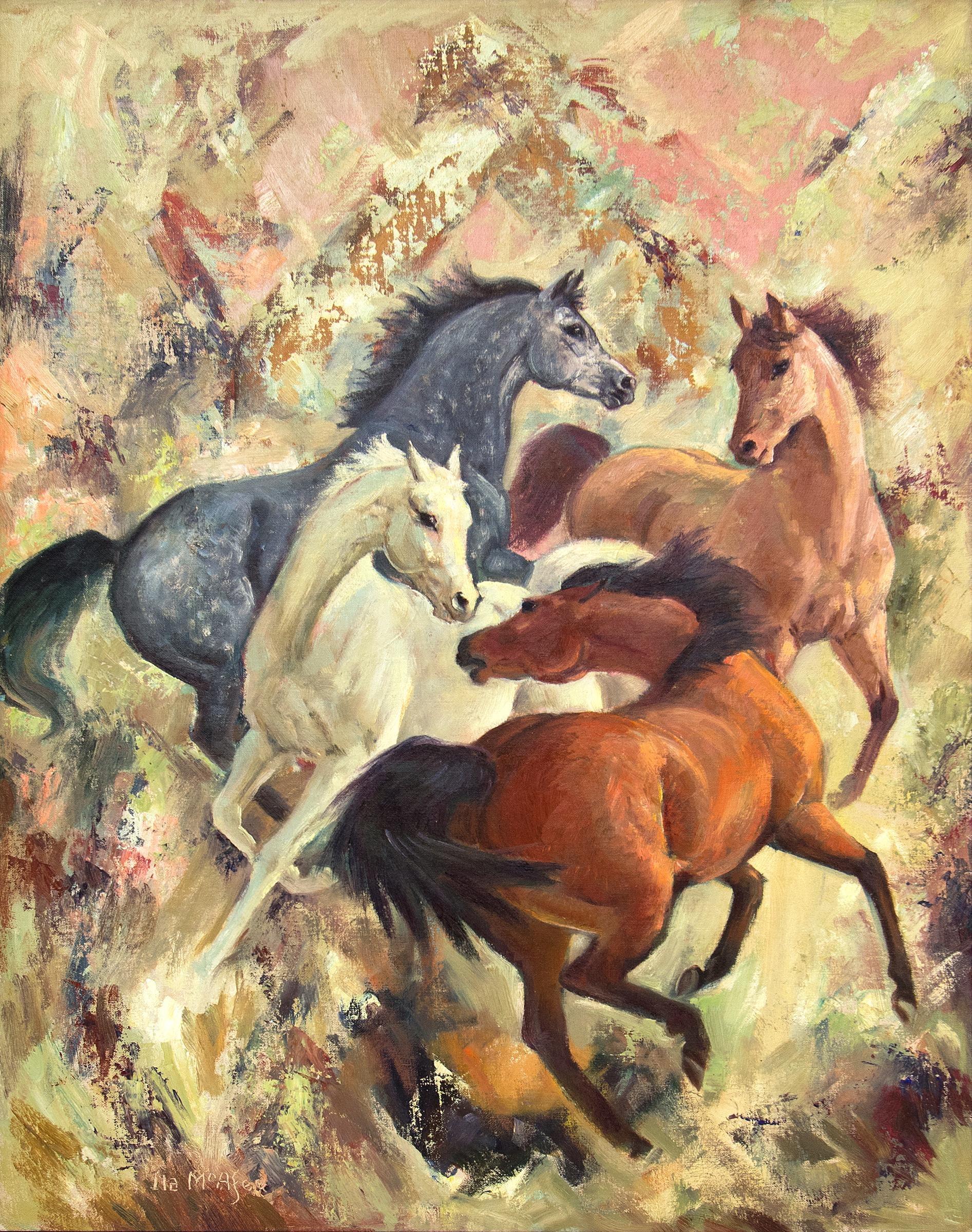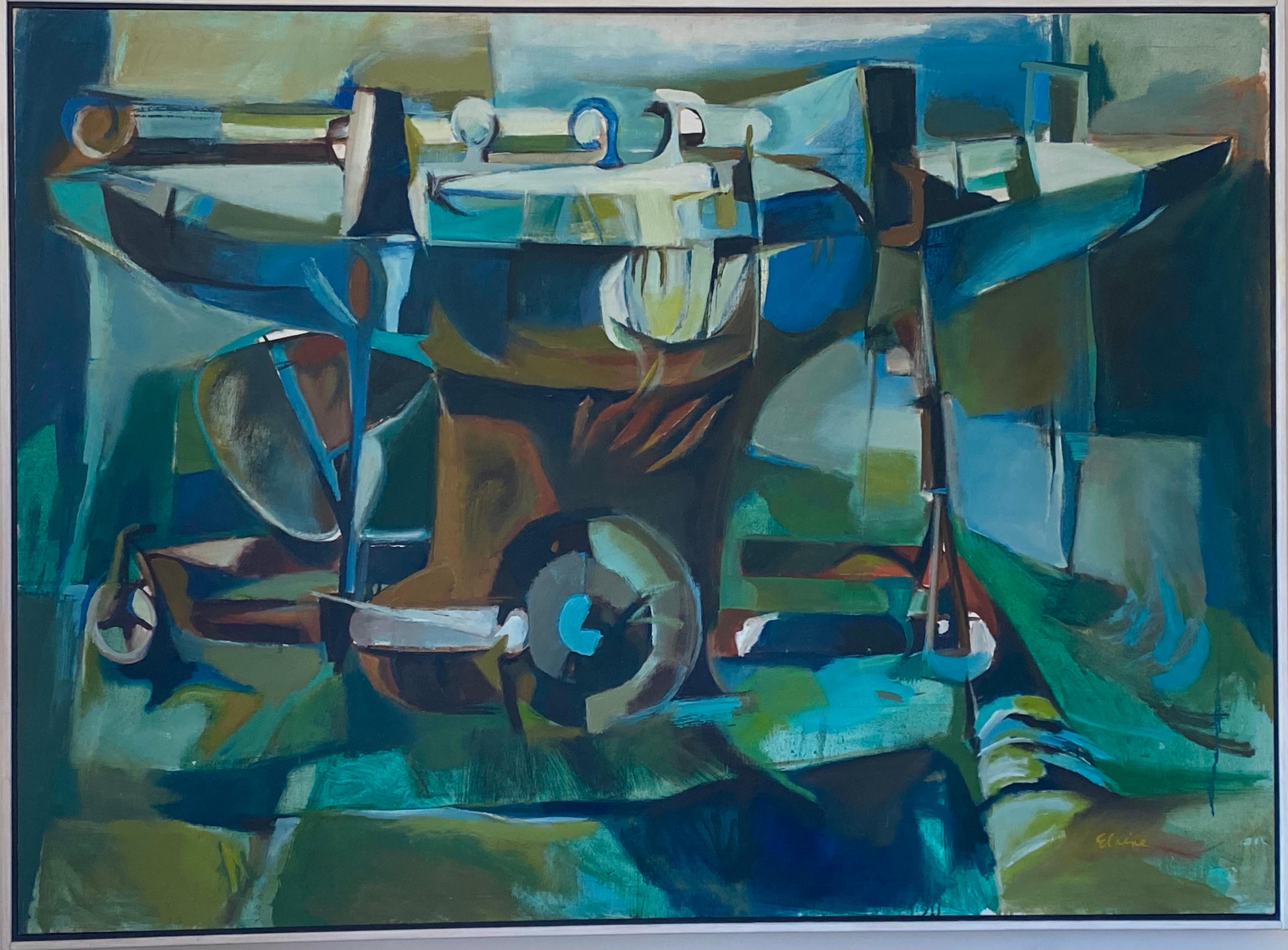Items Similar to Street Cleaners
Want more images or videos?
Request additional images or videos from the seller
1 of 5
Edward BibermanStreet Cleanersc. 1940s
c. 1940s
About the Item
This painting is part of our exhibition America Coast to Coast: Artists of the 1930s
Street Cleaners, c. 1940s, oil on canvas, signed lower right, 28 ¾ x 42 inches, Gallery Z labels verso; exhibited in When Artists Became Workers: The People’s Art Movement of the ‘30s & ‘40s, Works by Jewish Artists in California Collections, Judah L. Magnes Museum, University of California, Berkeley, December 8, 1996 to March 30, 1997 (listed in catalog); illustrated (film) Kaufman, Jeffrey, Brush with Life: The Art of Being Edward Biberman, 2007, (DVD release 2010), 85 minutes
Price On Request
About the Painting
Street Cleaners is a light-hearted, but thoughtful, American Scene painting by Edward Biberman. In many cases, Biberman’s optimism was reserved for his sun-drenched architectural paintings of Southern California, while his figural works were often hard-hitting in-your-face compositions addressing fundamental questions of human rights. This work mediates between the two extremes. In Street Cleaners, we see a group of Black laborers smiling and laughing as an older White man, presumably their supervisor, stands by looking displeased. It appears that the workers are sharing a story or a joke at the expense of their boss. Biberman turns the tables on the conventional 1940s view of race. Here, the workers are not in the minority. Rather, they are the majority, and the White supervisor is the odd man out. Biberman was a progressive, left leaning, and socially conscious artist, who portrayed the Black community with dignity and respect. Throughout his career, Biberman was fascinated with Labor. Whether depicting a Hollywood studio strike, a Labor Day parade, the construction of a building, or the brutality of labor suppression, Biberman conveys the humanity of his workers through careful and disciplined drawing and unique coloration.
About the Artist
Edward Biberman was born in Philadelphia, the son of Ukrainian Jewish immigrants. His artistic career started at the Pennsylvania Academy of Fine Arts followed by three years of study in Paris, where he associated closely with Calder and Noguchi and exhibited at the Salon d'Automne, Grand Palais, in 1927 and the Salon des Independents in 1929. Upon his return to the United States, Biberman spent time in New York City, where he showed at many of the city’s premier galleries and museums. His works were selected for several of the Museum of Modern Art’s early exhibitions of American artists, including 46 Painters and Sculptors Under the Age of 35 (1930) and Murals by American Painters and Photographers (1932). Hoping to escape the pressures of the New York art world, Biberman moved to Los Angeles in 1936 where he could be close to his family, including his film director brother, Herbert Biberman, and his sister-in-law, the Academy Award winning actress, Gale Sondergaard.
During the course of his long career, Biberman showed at the Salon d’Automne (Paris); Whitney Museum; Metropolitan Museum of Art, Museum of Modern Art, Corcoran Gallery, Los Angeles County Museum of Art (LACMA) and dozens of other museums and galleries across the US and in Europe. Biberman completed three murals for public works projects, including his work Abbot Kinney and the Story of Venice for the Venice Post Office, which was installed for six months at LACMA in 2014. His works are in the permanent collections of more than a dozen museums, including the National Portrait Gallery (of the Smithsonian Institution), Los Angeles County Museum of Art, Museum of Fine Arts, Houston, Butler Institute of American Art, and Pennsylvania Academy of Fine Arts. Several books are dedicated to Biberman’s art, as is a feature length documentary, Brush with Life: The Art of Being Edward Biberman (2007). Biberman’s art has undergone a resurgence of popularity during the past fifteen years with four solo or focused exhibitions, Edward Biberman Revisited (2009), Edward Biberman (2011-12), Lost Horizons: Mural Dreams of Edward Biberman (2014) and Edward Biberman, Abbot Kinney and the Story of Venice (2014), and representation in a number of other exhibitions, such as To Make a World: George Ault and 1940s America at the Smithsonian Institution and other institutions (2011), Pacific Standard Time (2012), Contraption: Rediscovering California Jewish Artists (2018),Black American Portraits (2021) at LACMA, Encounters in American Realism (2022) at The Westmoreland Museum of American Art and Art for the People WPA Paintings from the Dijkstra Collection (2023) at the Crocker Art Museum (Sacramento, CA), Oceanside Museum o f Art (Oceanside, CA) and The Huntington Library, Art Museum and Botanical Gardens (San Marino, CA).
Biberman’s brand of modernism can fairly be divided into four categories 1) precisionist urban scenes of New York and Southern California which celebrate the creations of humanity; 2) portraits which expose not only the historical context, but also the souls, of his subjects; 3) rural landscapes and still life paintings which portray the beauty of America and its flora; and 4) social realist works which explore the struggles, hopes and shortcomings of our society. Regardless of genre, Biberman had a unique sense of structure and color. His figures are at the same time specific and universal. Taken as a whole, Biberman’s body of work presents the viewer with a compelling and often daring vision of 20th century America and its art.
- Creator:Edward Biberman (1904 - 1986)
- Creation Year:c. 1940s
- Dimensions:Height: 28.75 in (73.03 cm)Width: 32 in (81.28 cm)Depth: 2 in (5.08 cm)
- Medium:
- Movement & Style:
- Period:
- Condition:
- Gallery Location:Los Angeles, CA
- Reference Number:1stDibs: LU1859213055402
About the Seller
No Reviews Yet
Vetted Seller
These experienced sellers undergo a comprehensive evaluation by our team of in-house experts.
1stDibs seller since 2022
6 sales on 1stDibs
Typical response time: 2 hours
- ShippingRetrieving quote...Ships From: Los Angeles, CA
- Return PolicyA return for this item may be initiated within 3 days of delivery.
More From This SellerView All
- Six O'ClockLocated in Los Angeles, CASix O-Clock, c. 1942, oil on canvas, 30 x 20 inches, signed and titled several times verso of frame and stretcher (perhaps by another hand), marked “Rehn” several times on frame (for the Frank K. M. Rehn Galleries in New York City, who represented Craig at the time); Exhibited: 1) 18th Biennial Exhibition of Contemporary American Oil Paintings from March 21 to May 2, 1943 at The Corcoran Gallery of Art in Washington, D.C. #87, original price $450 (per catalog) (exhibition label verso), 2) Craig’s one-man show at the Frank K. M. Rehn Galleries, New York City, from October 26 to November 14, 1942, #10 (original price listed as $350); and 3) Exhibition of thirty paintings sponsored by the Harrisburg Art Association at the State Museum of Pennsylvania in Harrisburg in March, 1944 (concerning this exhibit, Penelope Redd of The Evening News (Harrisburg, Pennsylvania) wrote: “Other paintings that have overtones of superrealism inherent in the subjects include Tom Craig’s California nocturne, ‘Six O’Clock,’ two figures moving through the twilight . . . .” March 6, 1944, p. 13); another label verso from The Museum of Art of Toledo (Ohio): original frame: Provenance includes George Stern Gallery, Los Angeles, CA About the Painting Long before Chris Burden’s iconic installation outside of the Los Angeles County Museum of Art, Urban Light, another artist, Tom Craig, made Southern California streetlights the subject of one of his early 1940s paintings. Consisting of dozens of recycled streetlights from the 1920s and 1930s forming a classical colonnade at the museum’s entrance, Burden’s Urban Light has become a symbol of Los Angeles. For Burden, the streetlights represent what constitutes an advanced society, something “safe after dark and beautiful to behold.” It seems that Craig is playing on the same theme in Six O-Clock. Although we see two hunched figures trudging along the sidewalk at the end of a long day, the real stars of this painting are the streetlights which brighten the twilight and silhouette another iconic symbol of Los Angeles, the palm trees in the distance. Mountains in the background and the distant view of a suburban neighborhood join the streetlights and palm trees as classic subject matter for a California Scene painting, but Craig gives us a twist by depicting the scene not as a sun-drenched natural expanse. Rather, Craig uses thin layers of oil paint, mimicking the watercolor technique for which he is most famous, to show us the twinkling beauty of manmade light and the safety it affords. Although Southern California is a land of natural wonders, the interventions of humanity are already everywhere in Los Angeles and as one critic noted, the resulting painting has an air of “superrealism.” About the Artist Thomas Theodore Craig was a well-known fixture in the Southern California art scene. He was born in Upland California. Craig graduated with a degree in botany from Pomona College and studied painting at Pamona and the Chouinard Art School with Stanton MacDonald-Wright and Barse Miller among others. He became close friends with fellow artist Milford Zornes...Category
1940s American Modern Landscape Paintings
MaterialsCanvas, Oil
- Gold Mine, Central City, ColoradoBy Joseph MeertLocated in Los Angeles, CAThis painting is part of our exhibition America Coast to Coast: Artists of the 1930s Goldmine, Central City, Colorado, oil on canvas, 36 x 28 inches, c. 1936, signed lower right, ex collection of Platt Fine Art, Chicago, Illinois (label verso). About the Painting Joseph Meert’s painting, Goldmine, Central City, Colorado, depicts the short-lived resurrection of a once prominent city just outside Denver. Central City was founded in 1859 soon after John Gregory struck gold in the area. As word spread, thousands of miners converged into “Gregory’s Gulch” and its surroundings became known as the “richest square mile on earth.” Mining production quickly increased resulting in Central City to becoming Colorado’s largest city in the early 1860s. Despite some technical difficulties transitioning to lode mining and the rise of competition from Leadville, Central City remained an economic boom town through the turn of the century. But, with every boom, there is a bust. World War I marked the end of Central City’s prominence as ore production ground to a halt and by 1925, the town’s population shrank to only 400 people. The desperation of the Great Depression and a nearly 100% increase in the price of gold lured labor and capital back to Central City. Meert painted in Colorado during the mid-1930s, a time when he created his most desirable works. It is during this period of renaissance that Meert captures one of Central City's outlying dirt streets bordered by 19th century wooden houses from the town's heyday and the more recently installed electric lines leading to a distant gold mine. A lone figure trudges up the hill, a mother with a baby in her arms, putting us in mind of the rebirth of the town itself. Meert had solo exhibitions at the Colorado Springs Fine Arts Center in 1936 and the Denver Art Museum. Although it is not known whether Goldmine, Central City was included in either of these exhibitions, it seems likely. Moreover, the painting is closely related to Meert’s painting, The Old Road, which was painted in 1936 and exhibited at the Corcoran Gallery of Art in Washington, DC and at the Dallas Museum of Art. About the Artist Joseph Meert was a well-regarded painter and muralist, who initially made a name for himself in the American Scene and later as an abstract expressionist. Although initially successful, Meert struggled financially and with mental illness later in life. He was born in Brussels, Belgium, but moved with his family to Kansas City, Missouri. As a child, a chance encounter at the Union Pacific Railyard changed his life. Meert happened upon a worker repainting and stenciling a design on a railroad car. Meert later recalled that this experience introduced him to the idea of being a painter. Without support from his father, Meert obtained a working scholarship to the Kansas City Art Institute. After four years at the Kansas City Art Institute, Meert studied seven years at the Art Students League and in Europe and Los Angeles. At the Art Students League, Meert fell under the spell of Thomas Hart Benton and Stanton MacDonald-Wright. In 1931, he befriended Jackson Pollock. By 1934, Meert was part of the Public Works of Art Project when he met his wife, Margaret Mullin...Category
1930s American Modern Landscape Paintings
MaterialsOil, Canvas
- Subway ConstructionLocated in Los Angeles, CAThis painting is part of our exhibition American Coast to Coast: Artists of the 1930s Subway Construction, c. 1928, oil on board, 19 x 15 ¾ inches, signed upper left, artist and title verso; exhibited: 1) 12th Annual Exhibition of the Society of Independent Artists, The Waldorf Astoria, New York NY, from March 9 to April 1, 1928, no. 864 (original price $250) (see Death Prevailing Theme of Artists in Weird Exhibits, The Gazette (Montreal, Quebec, Canada), March 8, 1928); 2) Boston Tercentenary Exhibition Fine Arts and Crafts Exhibition, Horticultural Hall, Boston MA, July, 1930, no. 108 (honorable mention - noted verso); 3) 38th Annual Exhibition of American Art, Cincinnati Art Museum, Cincinnati, OH, June, 1931 (see Alexander, Mary, The Week in Art Circles, The Cincinnati Enquirer, June 7, 1931); and 4) National Art Week Exhibition [Group Show], Montross Gallery, New York, New York, December, 1940 (see Devree, Howard, Brief Comment on Some Recently Opened Exhibitions in the Galleries, The New York Times, December 1, 1940) About the Painting Ernest Stock’s Subway Construction depicts the excavation of New York’s 8th Avenue line, which was the first completed section of the city-operated Independent Subway System (IND). The groundbreaking ceremony was in 1925, but the line did not open until 1932, placing Stock’s painting in the middle of the construction effort. The 8th Avenue line was primarily constructed using the “cut and cover” method in which the streets above the line were dug up, infrastructure was built from the surface level down, the resulting holes were filled, and the streets reconstructed. While many artists of the 1920s were fascinated with the upward thrust of New York’s exploding skyline as architects and developers sought to erect ever higher buildings, Stock turned his attention to the engineering marvels which were taking place below ground. In Subway Construction, Stock depicts workers removing the earth beneath the street and building scaffolding and other support structures to allow concrete to be poured. Light and shadow fall across the x-shaped grid pattern formed by the wooden beams and planks. It is no surprise that critics reviewing the painting commented on Stock’s use of an “interesting pattern” to form a painting that is “clever and well designed.” About the Artist Ernest Richard Stock was an award-winning painter, print maker, muralist, and commercial artist. He was born in Bristol, England and was educated at the prestigious Bristol Grammar School. During World War I, Stock joined the British Royal Air Flying Corps in Canada and served in France as a pilot where he was wounded. After the war, he immigrated to the United States and joined the firm of Mack, Jenny, and Tyler, where he further honed his architectural and decorative painting skills. During the 1920s, Stock often traveled back and forth between the US and Europe. He was twice married, including to the American author, Katherine Anne Porter. Starting in the mid-1920s, Stock began to exhibit his artwork professionally, including at London’s Beaux Arts Gallery, the Society of Independent Artists, the Salons of America, the Cincinnati Art Museum, the Whitney Studio and various locations in the Northeast. Critics often praised the strong design sensibility in Stock’s paintings. Stock was a commercial illustrator for a handful of published books and during World War II, he worked in the Stratford Connecticut...Category
1920s American Modern Figurative Paintings
MaterialsOil
- Riders of Pigeon HillBy Jon CorbinoLocated in Los Angeles, CARiders of Pigeon Hill, c. 1940s, oil on canvas, signed lower right, 24 x 36 inches, label verso with title, artist’s name and address; same information inscribed verso; ex-collection...Category
1940s American Modern Paintings
MaterialsCanvas, Oil
- Untitled (Elevated Platform)Located in Los Angeles, CAThis painting is part of our current exhibition - America Coast to Coast: Artists of the 1940s Untitled (Elevated Platform), 1950, oil on canvas, signed and dated lower right, 30 x...Category
1950s American Modern Paintings
MaterialsCanvas, Oil
- Untitled (Transcendental Composition)By Charles Ragland BunnellLocated in Los Angeles, CAThis work is part of our exhibition - America Coast to Coast: Artists of the 1940s Untitled (Transcendental Composition), oil on board, 1947, oil on board, signed and dated lower r...Category
1940s American Modern Paintings
MaterialsOil, Board
You May Also Like
- Yellow Symphony #1Located in Bogotá, BogotáThis horizontal painting on canvas contains several layers of color, with textures and transparencies, representing a dreamlike scene where fantastic animals and humans in yellow and...Category
2010s American Modern Figurative Paintings
MaterialsOil, Canvas
- "Audience" Mid 20th Century American Figurative Theatre Performance ContemporaryBy Leon BibelLocated in New York, NY"Audience" Mid 20th Century American Figurative Theatre Performance Contemporary Leon Bibel (1912 - 1995) "The Audience," 52 ½ x 41 ¼ inches. Oil on canvas, c. 1963. Signed lower right. Framed. BIO Painter, printmaker and sculptor, Leon Bibel was born in San Francisco in 1913. He trained at the California School of Fine Arts and received a scholarship to study under the German Impressionist Maria Riedelstein. He worked in collaboration with Bernard Zackheim, a student of Diego Rivera, to create frescoes for the San Francisco Jewish Community Center and the University of California Medical School. In 1936 Bibel moved from California to join the Federal Art Project at Harlem Art...Category
1960s American Modern Figurative Paintings
MaterialsCanvas, Oil
- 1970s Abstract Figurative Framed Oil Painting, Modernist City Scene With CoupleLocated in Denver, CO1950s oil on board painting by George Cecil Carter portraying a modernist couple, thought to be Alfred Stieglitz & Georgia O'Keefe. Presented in a custom frame, outer dimensions measure 20 ⅝ x 13 ½ x 1 ⅞ inches. Image sight size is 16 ⅞ x 9 ⅞ inches. Painting is clean and in very good vintage condition - please contact us for a complete condition report. Provenance: Private Collection, Denver Colorado Expedited and international shipping is available - please contact us for a quote. About the Artist: George Cecil Carter was born in Oklahoma in 1908 and became a noted Colorado abstract expressionist alongside contemporaries including Al Wynne, Mary Chenoweth...Category
1950s American Modern Figurative Paintings
MaterialsOil, Board
- A Little Nippy, Framed Oil Painting with Horses, New Mexico Female ArtistBy Ila Mae McAfeeLocated in Denver, COOil on canvas board painting by Ila Mae McAfee (1987-1995) titled "A Little Nippy" portraying four horses in different color tones. Signed by the artist in the lower left corner and titled verso. Presented in a custom frame, outer dimensions measure 33 ½ x 27 ½ x 1 ⅜ inches. Image size is 27 ⅞ x 21 ¾ inches. Painting is clean and in very good vintage condition - please contact us for a detailed condition report. Provenance: Private Collection, Denver, Colorado Expedited and international shipping is available - please contact us for a quote. About the Artist: As a girl growing up in a ranching community near Gunnison, Colorado, Ila McAfee loved to ride horses and to make sketches. Riding ten-miles round trip to school and back, she developed empathy for these magnificent animals, which remained with her and served as the basis for her life in art. Gathering any scraps of paper that she could find, she drew their forms, and her first full image of a horse was in the family Bible. As an adult, she declared, “I just imagine them as if their being existed in a mythological realm.” McAfee went to Los Angeles and studied at the West Lake School...Category
Mid-20th Century American Modern Animal Paintings
MaterialsOil
- The Green BoatBy Elaine Badgley ArnouxLocated in Burlingame, CAMid century modern masterwork, 'The Green Boat', by celebrated American woman artist, Elaine Badgley Arnoux. Painted in 1958 in the artists's unique style, ...Category
21st Century and Contemporary American Modern Still-life Paintings
MaterialsCotton Canvas, Oil
- Seymour Remenick Figurative Oil Painting "Folk Singers"By Seymour RemenickLocated in Surfside, FLSeymour Remenick (1923-1999) American; Philadelphia, PA. Oil on canvas painting Folk Singers and musicians.Seymour Remenick (1923-1999), was born in Detroit, Michigan and raised in ...Category
1950s American Modern Figurative Paintings
MaterialsCanvas, Oil
Recently Viewed
View AllMore Ways To Browse
Paris Street Oil
Old Vintage Street Signs
Edward View
Paris 1930 Street
Philadelphia Street
Modern American Street Scene
Vintage F1 Art
Edward Dayes
Venice Street Scene
Modern Figurative Street Scene
L Street Vintage
Modern European Street Scene
Labor Day
Vintage Los Angeles Street Signs
Edward Hoper
1940s Sun
1940 Street Scenes
Ukrainian Jewish




